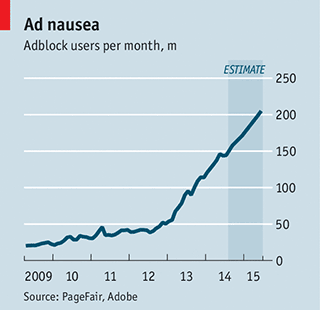Internet users are increasingly installing ad blockers
 Advertising agencies are sounding the alarm : they are losing their audience online. More and more users are installing ad blockers and falling out of advertisers ’view. The diagram on the left shows the number of users who use the ad blocker. As we see, since 2013 there has been a sharp increase in the popularity of these programs.
Advertising agencies are sounding the alarm : they are losing their audience online. More and more users are installing ad blockers and falling out of advertisers ’view. The diagram on the left shows the number of users who use the ad blocker. As we see, since 2013 there has been a sharp increase in the popularity of these programs.During 2013-2014, the number of blocker users has tripled: from 50 million to 150 million people, and there is a tendency for further growth. According to experts, at the moment the audience of “refusers” exceeds 200 million people.
This trend threatens the traditional business model of publishing online, which involves placing free content in exchange for viewing ads.
The company Eyeo, which produces the most popular Adblock Plus program among similar programs, speaks of more than 400 million downloads of this browser extension.
')
Until recently, advertising was blocked only on personal computers and laptops, but now such software is installed even on mobile devices, which are increasingly used for surfing the Web. This fact saddens advertisers even more.
In previous years, ad blockers were considered the lot of technically advanced users. They were not too easy to install and configure. But now they are installed in two clicks as Chrome or Firefox extensions, and work fine right out of the box according to the prepared blacklist.
By using such programs, people are pushed by the websites themselves, which put aggressive advertising formats: videos, flash animation and pop-ups.
Judging by the statistics, young users are the most intolerant of such advertising. Authors of market research from Wells Fargo Securities say that as these users mature, the overall popularity of ad blockers will increase.
Few media companies decide to publish their losses from the fact that the audience cuts advertising on websites. For example, the German media group ProSiebenSat.1 stated that in 2014 it suffered because of this loss in the amount of € 9.2 million. This is about one fifth of the company's revenues from the activities on the Internet.
Companies that work for a male audience with a technical background are the hardest hit. Here, the popularity of ad blockers is maximum. For example, among visitors of Geektimes such programs are used by 93% of the audience .
Publishers are trying to somehow respond to this situation. For example, they place ads not in the form of graphic banners, but in the form of advertising articles. Others try to influence the audience and talk about the dangers of blockers. For example, the site of the British newspaper Guardian displays the following message: “We noticed that you have installed a program to block ads. Perhaps you would like to support the Guardian in a different way? "
Other sites are even tougher. For example, the Hulu video site does not allow users who have banner-cutters installed. In Germany, some media sued Eyeo. The fact is that the program of this company does not cut all advertising, but does it selectively: it skips some banners if they are not “annoying” (in reality, if the advertiser contributed a certain amount of money to Eyeo). There is information that Eyeo has entered into such an agreement, including with Google.
However, according to the results of two lawsuits, Eyeo is acquitted. The court decided that it has the right to conduct such business practice, since users are notified in advance of the presence of a “white list”. But even if Eyeo is sued, it will not stop other ad blocking software developers. Many such projects are being created by the community and will most likely continue to work.
Advertisers are hoping for the help of Apple and Google, which may prohibit the installation of blockers on mobile devices running under their operating systems. But again, any limitations there can be overcome after the device has been rooted. You can install a third-party browser, which is originally embedded lock function. Recently, this was released under the brand Adblock .
Source: https://habr.com/ru/post/367341/
All Articles